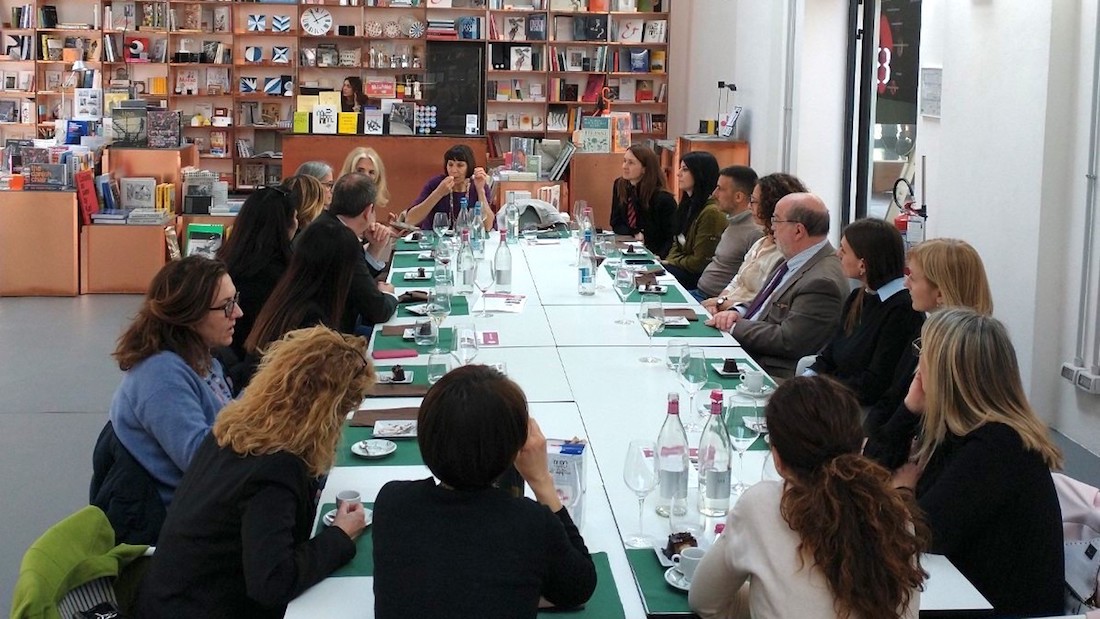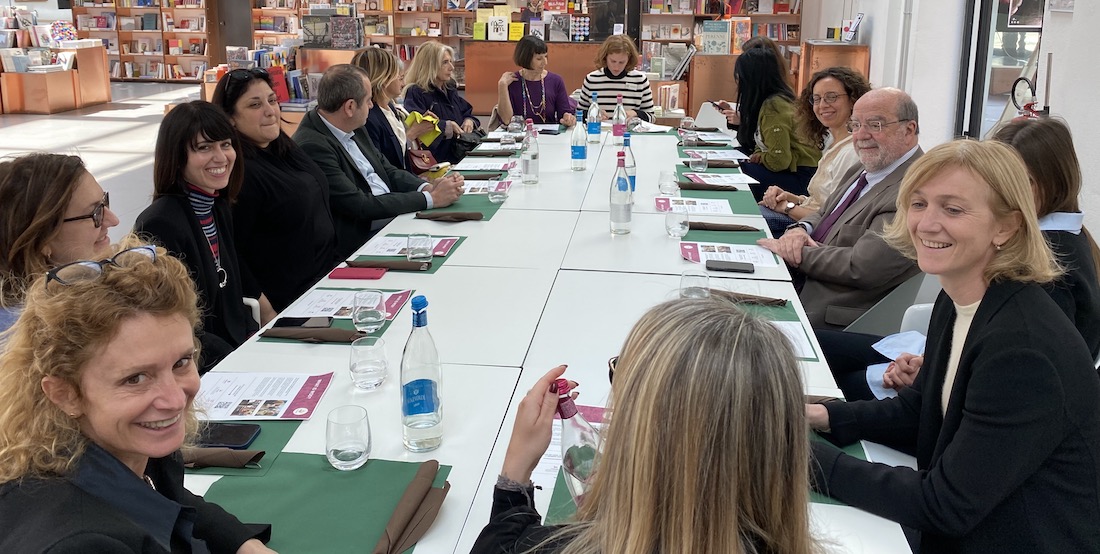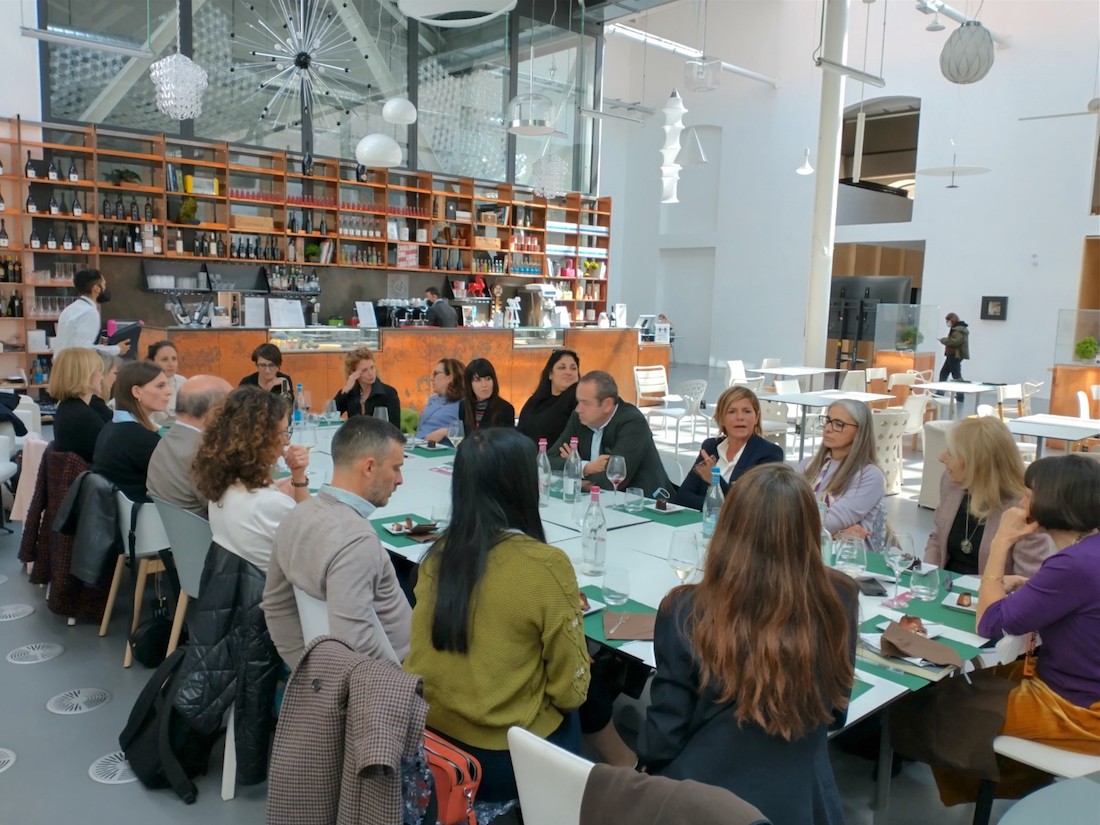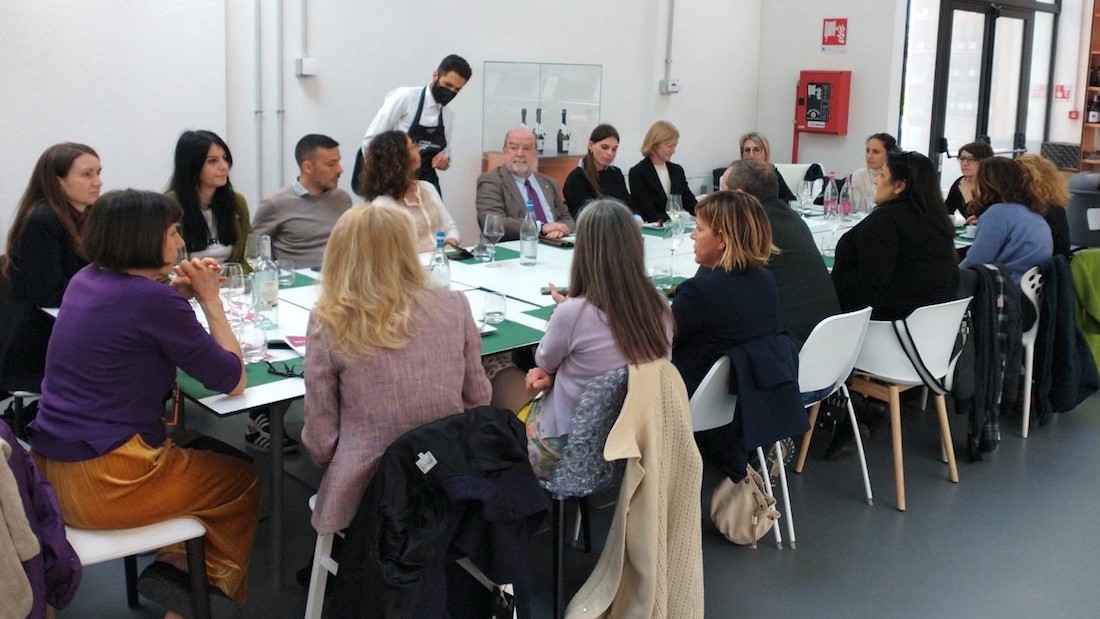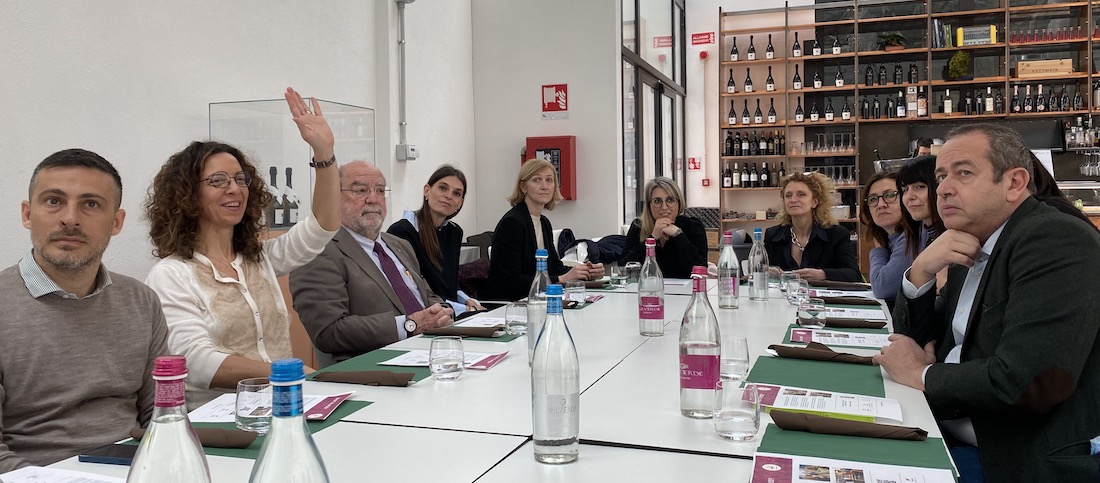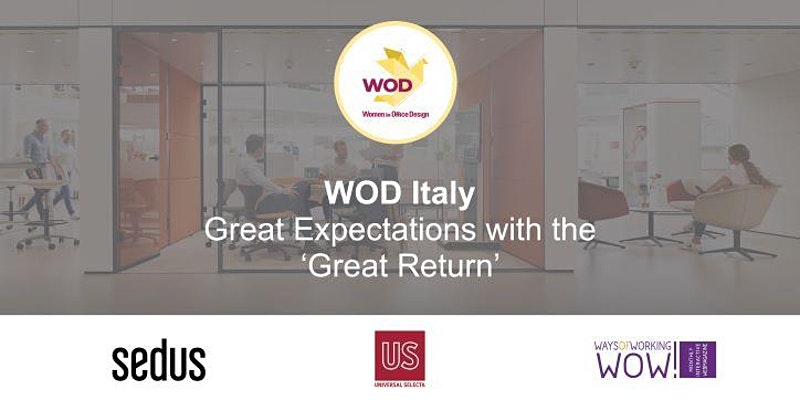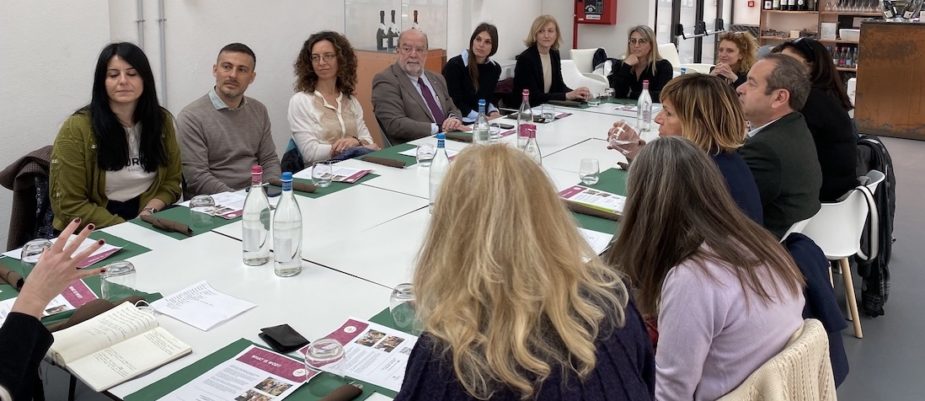
The first, convivial round table of WOD Italia (Women in Office Design) entitled “Great Expectations with the Great Return” organized in collaboration with WOW! Webmagazine and sponsored by Sedus Italia and Universal Selecta, took place in the splendid ADI Museum in Milan.
The female minds of 15 prominent design studios shared their ideas on one of the hottest topics: the return to the post-pandemic workplace.
How are companies encouraging their employees to return to the office? Is it possible to change the idea of the office from a space where employees need to be, to a place where they want to be?
We tried to reflect together and find answers. The following report is a summary of the main concepts emerged.
The decision to bring together in this lively light lunch a small number of designers and office design professionals, working in architectural firms of various sizes, multinational integrated design companies and global real estate services companies, was certainly winning and stimulating for the debate.
This variety has allowed us to compare very different experiences and points of view – sometimes contradictory – and to have a representative scenario of the Italian reality made up not only of large companies but above all of small and medium-sized enterprises, caught off guard by the transformations imposed by covid pandemics and still not ready – neither culturally nor in terms of technology and organization – for the “real” change towards “real” smart working.
Therefore, a complex, non-homogeneous, sometimes chaotic reality emerges, with approaches and choices that are certainly not generalizable to give concrete answers to the “Great Return”, in reality a “Second Great Return” with higher expectations by employees, often disappointed.
If the first return to the office, after the most dramatic pandemic wave and the lock down, was experienced with enthusiasm by everyone as a possibility to get out of isolation and return to social life, today workers have had time to elaborate this. experience and discovered that home working has its advantages too. Now they need to find valid reasons to justify the need to return to the office.
For example, the value of family and relationships with roommates has been rediscovered, the importance of managing time independently; with a consequent refusal of long times wasted on the journey home / office.
Above all, priorities have changed. Although with lower percentages than in other countries, Italy is also experiencing the YOLO phenomenon and the younger generations have different goals that go well beyond work-life balance: freelance businesses and start-ups are growing.
While appreciating the value of teamwork, this type of digitally talented worker, growing up with a vision of smart living, has different objectives, cannot accept the old idea of coercive work, based on control rather than trust; on the amount of time rather than on the results obtained. Much depends on the position and the role one covers, but even the older generations ask themselves some questions or ask for early resignation…
How do companies organize the big comeback?
It is essential to make a distinction between those who, even before the pandemic, applied smart working or at least had started this path and companies that worked in a traditional way. Among the latter, many large companies overwhelmed by the tornado of smart working now do not know which direction to go, in many cases continue to postpone the fateful Great Return from month to month.
Or they go back to the past by denying any organizational change (in particular small family businesses and professional firms) by imposing h 9 am/5 pm.
The curious fact is that many of these companies (with offices of 300/400 square meters) consider it is necessary to have “more beautiful”offices and ask for new design and redevelop to make them more welcoming and more modern.
The need to change spaces comes from the awareness that it is a useful lever to attract people; but they did not understand that – in order to works- the change in space must reflect organizational change.
Many companies were faced with this urgency, but without an organic project. And the risk of a quick change, without having made the correct path, is that it will result in failure.
Smart Working or Smart Washing?
The problems are lower for companies that have been applying true smart working for years. However, for everyone it is now clear that completely removing autonomy would have negative implications on engagement, so most companies (even some banks that have been the most reluctant to change) seem to be orienting themselves, in a rather simplistic way, towards re-entry in the office on a 2/3 days a week basis. But the number of companies that allows only 1 day a week remotely is also substantial.
This choice (can it work?) raises some drawbacks, first of all the so-called “Wednesday peak” with over-populated offices on the central days of the week and empty on days close to the weekend. It does not allow to optimize the space and probably not even to motivate the employee.
It must be said that Italian legislation and the most widespread management culture certainly do not facilitate more fluid solutions.
For large corporate companies, the main driver towards smart working is the rationalization of real estate assets with a revision of the spaces to make them more efficient and to reduce the ever-increasing management costs.
For small companies this driver is not so strong, but they are finally beginning to understand what smart working is. Of course applying the new ways of working means also activating change management, involving and accompanying people in this change.
The desire for a workplace close to home is among the first in the requests of employees and in this multifaceted panorama it is interesting to note an ongoing trend in the needs of real estate funds that in the new residential complexes also require Office Spaces.
In Italy we are still far from the Clubs & Hubs spread in the suburbs of many foreign cities, yet is beginning to take shape the hypothesis of micro-workspaces of just over 20 square meters or attractive pop-up offices to be rented to meet customers 10 minutes away from home; with low management costs and web technical assistance.
We can also reflect on more fluid uses for the workplace: spaces where the desk and working informal areas coexist and allow an evening change destination becoming a place to have a beer with friends.
The “start-up workplace” model with the coexistence of several companies also proves valid for large corporations because the comparison, in particular with the younger generations, has proved to be a stimulus and source of innovation.
Some banks have adopted mixed solutions with employees in smart working for half the week and representative spaces, beautiful, welcoming and informal, in the city center that welcome 50% of employees and also customers. for temporary aggregation activities.
In these cases it is clear that the main changes concern the architectural envelope project, rather than the interior design.
Is collaboration a value to be taken into account?
The YOLO vision and the advantages of home working seem to take precedence over a more collaborative vision of work.
Millennials are more used to committing themselves and know how to better manage their work independently, yet the exchange of experiences is essential; young people also need to gain experience in the field, to train they must also work with those who have already had experience.
Remote working must always be accompanied by places to interact and spaces designed to best meet this purpose.
How should the post-pandemic workplace be designed?
Therefore, the tendency to identify the office as a place to meet and collaborate is increasingly confirmed; if there is no need to interact, the work can be done remotely.
This changes the architectural concept of the workplace, but also changes the approach to interior design.
Finally, companies have understood that the office must be beautiful and are willing to invest a little more for the physical environment.
The space for the new ways of working must allow maximum flexibility – in time and functionality – and become usable for the three different generations who share the same office at the moment.
Making three different generations feel the sense of belonging to the brand is a big challenge for the designer.
It is not possible to impose a single use of space. And the Activity Based Working model is no longer current: space should no longer be designed on the activity, but on the person and based on quality standards (People Based Working).
Offices built only 5 years ago are no longer good: too many sofas and unused areas, few tops for the personal computer.
The “3-day peak” and the goal of encouraging collaboration have a strong impact on the logic of the layout, which can no longer be based on the sharing rules applied up to now.
Hybrid working mainly impacts on places to collaborate and on the conception of meeting rooms that become high-tech places: even without reaching the extremes of the hologram, the rectangular table with people in the presence must be replaced with worktops with shapes that allow the interaction of people in the presence and of third parties remotely who must take an active part through touch screens and interactive monitors.
But the main goal to attract people and stimulate the Great Return is to make people feel good, with an approach that goes beyond the ergonomics and wellness criteria applied up to now.
It is also about creating the brand experience, bringing the corporate culture to life through physical space, design, color and materials.
For this reason, the reference figure who can give indications in projects is increasingly the HR manager. The best projects are realized when the indications from the company are clear. But when clarity is lacking, it is up to the designer to make interviews, check lists and also to guess unexpressed needs in order to make suggestions.
We are in front of conceptual changes in the approach to the workplace that are equivalent to the revolution implemented by the Burolandschaft in the 1960s and translate a new working philosophy into space.
For the office to be truly attractive, the project means “taking care” of the employee, imagining the workplace as a “journey”, an experience that conveys surprises, positive emotions, stimulating encounters and wellbeing moments that other places cannot equate.
Designing spaces that do not concern only the physical dimensions but also the mental and psychic ones.
Here also new frontiers of design come into play linked to neuroscience and neuro aesthetics, psychology (think for example of the different behavior of introverted or extroverted people who enter a meeting room), scientific knowledge (for example circadian cycles, sensory perception, cognitive ergonomics) that can give design suggestions for layout, lighting, colors, textures and materials.
The retail sector has been applying these design methods for some time, obviously aimed at increasing the desire to buy.
A new topic of discussion opens up on this topic: someone speaks about “manipulation” attributing a moral value to these methods, while others argue that it makes no sense to be scandalized if scientific knowledge is consciously used to direct and stimulate people, to change the time and the approach to a space with the aim of feeling users better (an approach that Sedus calls Productive Wellbeing) because it would be naive to deny that the design of the workspace has productivity as its ultimate goal.
The topic remains open and will perhaps be a topic to be discussed in an upcoming WOD Lunch.
Text by Renata Sias
Thanks for their contribution to the WOD Lunch attendees:
Stefania Vacquin, 967 Arch
Maria Luisa Daglia, Agilite Solutions
Shelly Ben David, Base Interiors
Carlotta Zucca, Caccia Dominioni Zucca
Francesca Fattiboni, D3 Architetti Associati
Alessandra Radice, D3 Architetti Associati
Lisa Bricarello, E45
Lauren Thompson, Flokk
Silvia Impelluso, JLL
Lorena Iraldi, Paloma Architects
Katia Gentilucci, Progetto CMR
Licia Micolitti, Progetto CMR
Cristiana Cutrona, Revalue
Lorenzo Maresca, Sedus
Francesco Riva, Sedus
Piera Scuri, Spazio
Mariangela Frisardi, Storage Milano
Elena Caregnato, Unispace
Marco Predari, Universal Selecta
Renata Sias, WOW Webmagazine

